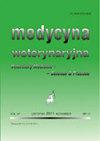炎症介质在子宫内膜异位症发展中的作用
IF 0.4
4区 农林科学
Q4 VETERINARY SCIENCES
Medycyna Weterynaryjna-Veterinary Medicine-Science and Practice
Pub Date : 2022-01-01
DOI:10.21521/mw.6722
引用次数: 0
摘要
马子宫内膜异位症是一种慢性退行性疾病,伴有进行性纤维化,形成于子宫内膜间质和子宫内膜腺体周围。马子宫内膜异位症引起子宫内膜细胞的组织学改变和分泌功能的改变。这些改变导致子宫内膜的改变和早期妊娠功能障碍。因此,这种情况是导致母马生育能力低下的主要原因之一,给马匹养殖业造成了巨大的经济损失。一般来说,纤维化的特征是细胞外基质(ECM)成分过度沉积。它破坏正常的组织结构,损害组织功能。与组织纤维化发展相关的细胞和分子事件是复杂的,而且人们知之甚少。近年来,人们对免疫细胞及其产物在马子宫内膜异位症发病中的作用进行了研究。这些研究主要集中在细胞因子,如转化生长因子(TGF)-β1、白细胞介素(IL) 6、IL-1β、前列腺素(PG)和中性粒细胞胞外陷阱(NET)成分,如髓过氧化物酶、组织蛋白酶G和弹性酶,在与子宫内膜异位症发展相关的最重要过程中的作用。结果表明,TGF-β1、IL-1β、IL-6和pg对肌成纤维细胞分化、成纤维细胞增殖、ECM蛋白沉积和基质金属蛋白酶(MMPs)及其抑制剂的表达有影响。这表明它们参与了与病理性子宫内膜重塑相关的过程。此外,子宫内膜组织对所选因素的反应根据子宫内膜异位症的分期而变化。炎症介质在纤维化相关过程中的作用表明炎症和子宫内膜异位症之间存在联系。本文章由计算机程序翻译,如有差异,请以英文原文为准。
The role of inflammatory mediators in the development of endometrosis in mare
Equine endometrosis is a chronic degenerative condition with progressive fibrosis that forms in the endometrial stroma and around the endometrial glands. Equine endometrosis causes histological changes and alterations in the secretory function of endometrial cells. These alterations lead to changes in the endometrium and early pregnancy dysfunction. Thus, this condition is one of the main causes of subfertility in mares, resulting in enormous economic losses to the horse-breeding industry. In general, fibrosis is characterized by excessive deposition of extracellular matrix (ECM) components. It destroys normal tissue architecture and compromises tissue function. The cellular and molecular events associated with the development of tissue fibrosis are complex and poorly understood. In recent years, research has been carried out on the involvement of immune cells and their products in the pathogenesis of endometrosis in mares. These studies focused mainly on the role of cytokines, such as transforming growth factor (TGF)-β1, interleukin (IL) 6, IL-1β, prostaglandin (PG), and components of neutrophil extracellular traps (NET), such as myeloperoxidase, cathepsin G, and elastase, in the most important processes associated with the development of endometrosis. The results showed that TGF-β1, IL-1β, IL-6, and PGs act on myofibroblast differentiation, fibroblast proliferation, deposition of ECM protein, and expression of matrix metalloproteinases (MMPs), and their inhibitors. It suggests their involvement in processes associated with pathological endometrial remodeling. Moreover, the response of endometrial tissue to selected factors changes according to the stage of endometrosis. The action of inflammatory mediators on processes related to the development of fibrosis shows a connection between inflammation and endometrosis.
求助全文
通过发布文献求助,成功后即可免费获取论文全文。
去求助
来源期刊

Medycyna Weterynaryjna-Veterinary Medicine-Science and Practice
VETERINARY SCIENCES-
CiteScore
0.80
自引率
0.00%
发文量
73
审稿时长
4-8 weeks
期刊介绍:
"Medycyna Weterynaryjna" publishes various types of articles which are grouped in the following editorial categories: reviews, original studies, scientific and professional problems, the history of veterinary medicine, posthumous memoirs, as well as chronicles that briefly relate scientific advances and developments in the veterinary profession and medicine. The most important are the first two categories, which are published with short summaries in English. Moreover, from 2001 the editors of "Medycyna Weterynaryjna", bearing in mind market demands, has also started publishing entire works in English. Since 2008 the periodical has appeared in an electronic version. The following are available in this version: summaries of studies published from 1999 to 2005, full versions of all the studies published in the years 2006-2011 (in pdf files), and full versions of the English studies published in the current year (pdf). Only summaries of the remaining studies from the current year are available. In accordance with the principles accepted by the editors, the full versions of these texts will not be made available until next year.
All articles are evaluated twice by leading Polish scientists and professionals before they are considered for publication. For years now "Medycyna Weterynaryjna" has maintained a high standard thanks to this system. The review articles are actually succinct monographs dealing with specific scientific and professional problems that are based on the most recent findings. Original works have a particular value, since they present research carried out in Polish and international scientific centers.
 求助内容:
求助内容: 应助结果提醒方式:
应助结果提醒方式:


